While sugar maple enjoys a sizeable market in the U.S and many cultivars are available, the Mexico mountain sugar maple or skutch maple, Acer saccharum ssp. skutchii, remains relatively unknown. This disjunct wing of sugar maple has endured over 9000 years of divergent evolution apart from relatives in eastern North America (4). The tree is similar in many respects to Acer saccharum, sugar maple, and Acer saccharum var. floridanum (syn. A. barbatum), the Florida maple, but features larger leaves, and perhaps the biggest samaras found in Aceraceae. The skutch maple offers opportunities for enhanced growth rate, interesting fall and spring foliage color, alkalinity tolerance, drought tolerance and good adaptation to well drained sunny locations in landscapes of the southern USA, east to west. Dirr lists 47 varieties of sugar maple in the industry (1). None include the diverse genetics of this western relative, the skutch maple of Mexico.
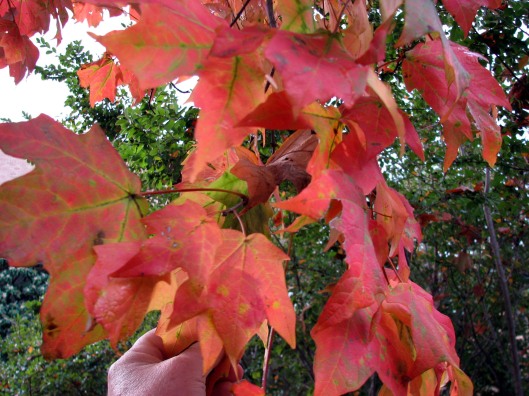
Fall color on the Skutch maple
Nature of Work: SFA Gardens comprises 128 acres (52 ha) of on-campus property at Stephen F. Austin State University (SFA), Nacogdoches, Texas. Initiated in 1985, SFA Gardens focuses on diversity, collections, rare and unusual species and cultivar collections, and promotes plants that perform well in East Texas and Louisiana landscapes. SFA Gardens has an extensive collection in the Aceraceae, with western genotypes well represented. The skutch maple is a genetic resource for breeders interested in improving growth rate, and drought, heat, and alkalinity tolerance.
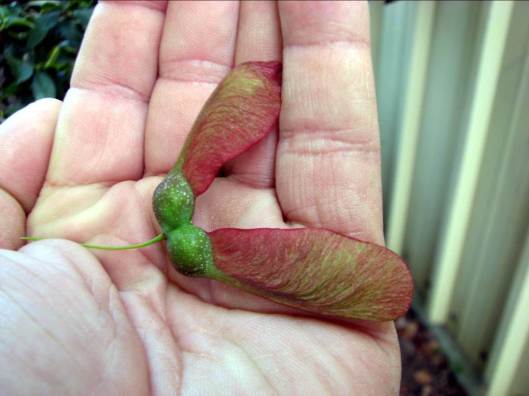
Background: In 1993, Simpson and Hipps assigned nine, possibly ten, maples to the southwestern USA (6). They noted that certain provenances of A. grandidentatum, Bigtooth maple, and the Caddo maple, a unique genotype of A. saccharum from southwestern Oklahoma, were particularly good performers in higher pH soils. Skutch maple, or the cloud forest sugar maple, Acer saccharum ssp. skutchii, is the least known in the USA and is the southern and western most sugar maple. It occurs naturally as six disjunct populations, with five in Mexico and one in Guatemala (7). First described in Guatemala in 1936 (5), the skutch maple is a rare relic from the Miocene era, probably separated from those in North America since the end of the Pleistocene over 9000 years ago (4). Lara-Gomez characterized variation in isolated skutch maple populations in Mexico (2). Yalma Luisa Vargas-Rodriguez, who graduated from Louisiana State University in 2005, hypothesized that the “six forest sites in Jalisco, Tamaulipas, Veracruz, and Hidalgo (Mexico) contain a unique and ancient flora, were connected and shared species before the Pleistocene, and currently function as tree refuges of that ancient flora” (8). Because of the small number of populations and low numbers in each population, Vargas-Rodriguez proposed to include Skutch maple in the IUCN Red List Catalog and as Endangered in the Guatemalan Species Red List. In fact, it’s even a bit more complicated. In a recent visit here at the SFA Gardens, I learned that Yalma believes the Jalisco population should be considered a brand new species, Acer benzayedii.
SFA Gardens Research: The oldest skutch maple at SFA Gardens was planted in 1994 and originated from seed collected in the Tamaulipas location (3) by John Fairey and Carl Schoenfeld of Yucca Do Nursery, Hempstead, Texas. Now twenty years old, the tree is 46 ft (14 m) tall with an 18 in (45.7 cm) diameter at breast height (dbh). It has grown well without irrigation, is oval shaped, exceptionally marcescent, and failed to develop showy fall color until after first flowering, an event that took 9 years to initiate. Fall color varies between butterscotch yellow to reds and oranges, depending on year.
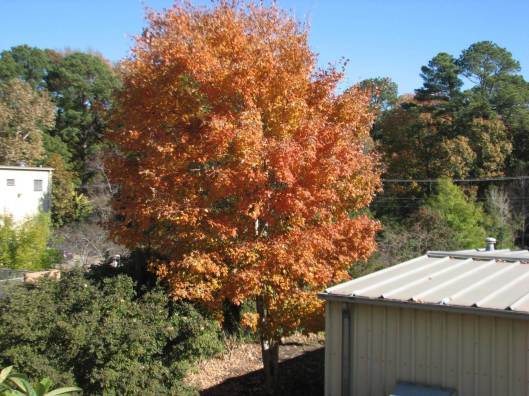
Image taken Dec 21, 2010
Propagation: The samaras are large and showy. In our location, seed are often empty, with viable seed at less than 10%. In 2009 the tree produced a heavy seed crop and we allowed the samaras to fall and then covered the area with an inch of pine bark fines. The end result was over one thousand seedlings emerging early (January) that were not affected by frosts in February. Seedlings were potted, grown and distributed to interested nurseries and university research programs. In our trials, cutting propagation of young seedling trees is feasible because of their juvenile nature. Still, after numerous cutting batches, we have noted a poor <20% rooting/survival rate. Best results are two node June cuttings using 1500 PPM K-IBA as a ten second basal end dip.
Research Plots: In January 2011 SFA Gardens established 277 skutch maples at SFA’s Science Research Center which is about five miles north and west of the campus.
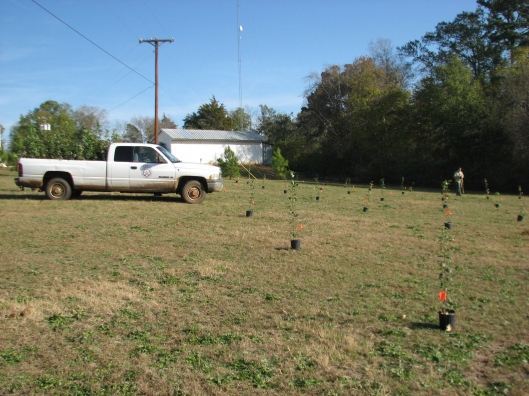
December 2010 planting of 277 Acer skutchii plants
The seedlings for this project were progeny of our sole flowering tree. The pollen source is unknown. However, there’s some reason to suspect self-pollination. First, sugar maples are generally considered to be wind-blown self-pollinators. While I’ve noticed bee activity on the Skutch maples and on our native maples, many researchers think that’s artifactual and wind is the primary mode of pollination. It’s complicated. Second, the flowering time of the skutch maple is slightly earlier than nearby Florida maples. Third, the performance of seedling batches in central Texas indicates a degree of alkalinity tolerance not shared by Florida maples. However, there remains the possibility that the distributed trees are hybrids with our local Florida maples. The goal of this project was to improve on seed availability, improve seed set and viability, and to select superior clones. This is a cooperative project with SFA’s College of Science and Mathematics through an informal agreement to use unutilized space at the Science Research Center for plant evaluation. The site is a full sun south facing gentle slope with a red clay loam (pH 6.7). SFA Gardens planted the seedlings spaced 15 ft (4.6 m) X 15 ft (4.6 m). Over the last three years, weed control has been backpack sprayer applications using glyphosate. The field drip irrigation system utilized ¾ inch black poly pipe with ½ gallon per hour emitters and a battery operated controller which delivered one to two gallons per plant per day during the irrigation season. The trees have not been pruned except to allow easier mowing and glyphosate application.
Fig 2. Skutch maple plots at SFA
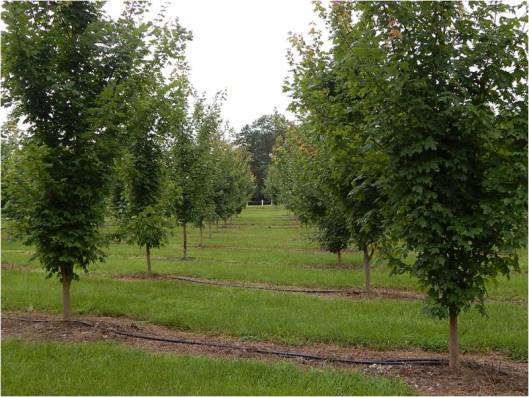
Climate: Nacogdoches is in Zone 8B of the Pineywoods region in East Texas with an average annual rainfall of 48 in (122 cm). June through August is characteristically hot and dry. 1 Sept 2000 was the record high, 112 F (44.4 C), and 23 Dec 1989 was the record low 0 F (-17.8 C). In 2010 and 2011, Nacogdoches experienced all-time record drought and heat. Total precipitation in 2010 was 22.3 in (56.6 cm) and 2011 produced 35.4 in (89.9 cm), with one third of that that coming late in the fall. Fortunately, 2012 and 2013 saw a return to normal summer temperatures and rainfall at 59.6 in (151 cm) and 43.4 in (110.2 cm), respectively.
Performance: Growth rate has been excellent. Trees were planted in January 2011. After three growing seasons, a 24 June 2014 random sample of 32 trees indicates an average tree height of 17.7 ft (5.4 m). The tallest trees exceed 21 ft (6.4 m) in height and 4.5 in (11.4 cm) in diameter. Diameter at six inches averaged 2.9 in (7.4 cm). This random sampling did not include any replants or damaged trees. Deer have been a constraint at this site, not through browsing but through bucks rubbing their racks on young trees. Over the past three years we have replanted 23 trees due to extreme deer damage. In other cases the trees sprouted vigorously below the damage and a new leader was chosen to restore the tree.
Results: This seedling block includes significant diversity. For instance, we note an 11 day variation from earliest to latest leaf emergence in the spring. There is great variety in the color of new growth (green, yellow, red, salmon, pink). Fall foliage color has been brown with leaves held tight into January before falling. However, there is evidence this species does not characteristically develop good fall color until after flowering. Most trees are not of good habit with haphazard branches, a tendency to multi-leader, and bad crotch angles. However, in this seedling block, there’s a variety of forms, including several fastigiate forms, one dwarf, and others with tighter habit and good shape. We have cutting propagated twelve selections and will be multiplying others in the next few years.
Fig 3. Spring growth
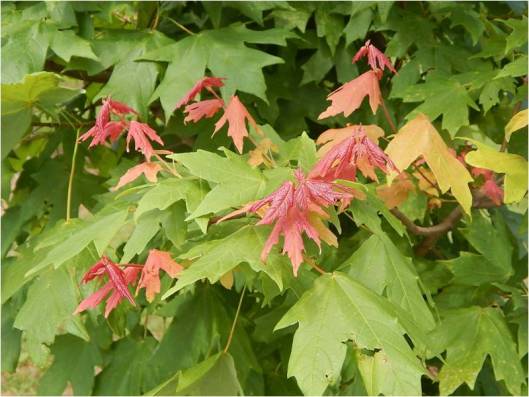 Genetic characterization. Very little is understood about the genetic diversity in this species. Von Gomez noted that this rare endemic is only known from six locations. They observed the variation in three small populations from two locations. Total variation was low. The smallest pop at Manantlan with only 26 plants revealed the least genetic diversity. Von Gomez suggested focusing on larger populations for in situ conservation work, and creating a plantation from all the populations to capture the maximum amount of available diversity.
Genetic characterization. Very little is understood about the genetic diversity in this species. Von Gomez noted that this rare endemic is only known from six locations. They observed the variation in three small populations from two locations. Total variation was low. The smallest pop at Manantlan with only 26 plants revealed the least genetic diversity. Von Gomez suggested focusing on larger populations for in situ conservation work, and creating a plantation from all the populations to capture the maximum amount of available diversity.
SFA Gardens is cooperating with Jason Grabosky, Rutgers University, New Brunswick, New Jersey in a maple characterization study. April Jackson, PhD candidate, is investigating variation within and among taxa included in the hard maple group. In particular, she is studying Acer saccharum, Acer nigrum, Acer barbatum, and Acer leucoderme. Populations of Acer grandidentatum as well as Acer skutchii were also represented in these studies. April is studying morphological, anatomical, and physiological traits that may enable species tolerance to water deprivation and increasing temperatures. She is genotyping germplasm collected over the last three years across natural ranges of the taxa to determine how genetically similar (or not) these taxa are. She will use phylogenetic analysis to address taxonomic discrepancies within this group of taxa and hopes to resolve classification and nomenclature listings. We are also cooperating with Richard Olsen of the National Arboretum, Beltsville, Maryland, in a similar project. In 2015, we hope to sample both our research plots and trees known to have originated from Mexico seed to determine parentage. Finally, our long term goal is to acquire seed of other provenances in Mexico, and, hopefully, Guatemala, to develop a documented ex situ collection of this species at SFA Gardens.
Cooperator observations
Brent Pemberton, Research Scientist, Texas Agrilife Research and Extension Center, Overton, TX: “We’ve had Acer skutchii in the ground for one full growing season. Looks good but still a small tree. It did survive all the cold weather this past year including 16oF on Mar 3 after only being in the ground for one season.”
Paul Cox, San Antonio Botanical Garden, San Antonio, TX (retired): “Acer skutchii at the SABG has put on the same height growth as Taxodium mucronatum during the first 10 years. It’s fast. Leaves have never scorched but don’t have the dramatic fall color reported from other areas.”
James Spivey, nurseryman, Peerless Nursery, Bigfoot , TX: “Acer skutchii has a great deal of potential in the tree market for the Central and South Texas. It seems to be very tolerant of alkaline soil around San Antonio and the Hill Country. It has been very tolerant of heat and direct sunlight without any burning of the foliage. The growth rate has been 3-1/2′ to 4′ per year under irrigation.”
Mike Arnold, Research Scientist, Texas A & M University, College Station, Texas: “Nice plant in areas without saline soils or irrigation water. We have killed it repeatedly in multiple locations here due to the salts in the irrigation water. Chlorosis due to alkalinity does not appear to be nearly as serious as the salts. It develops the classic marginal necrosis and then dieback and death. It just is intolerant of the salts.” In an earlier correspondence, Mike reported Acer skutchii had failed to deal with the high salinity irrigation water in College Station (250 PPM Na and 500 PPM bicarbonates). Whether irrigated by drip, sprinkler or microsprinklers, plants performed poorly. Leaves were cupped and took on a bluish cast, and the trees failed to survive in their container trials.
Steve Lowe, Naturalist, Kendall County Park. Boerne, TX: “Acer skutchii is remarkably well adapted for this area. After visiting these trees in their home range, it is easy to see their affinity for limestone. They are truly saxicolous. This would explain their tolerance of our high pH soils, outperforming even our native Bigtooth maples. Skutch maples I’ve planted in this area have consistently grown 3-4+ feet per year with only moderate irrigation. As with the Sierran oaks, new growth is extra early here, pink/brown and sometimes subject to cold damage. Most here attain peak color end of December (citron to canary yellow to pumpkin). Foliage color and texture (more leathery) seems to change as tree matures.”
Jim Robbins, University of Arkansas, Little Rock and Hope, Arkansas: “In 2011, twelve one quart plants were donated by SFA Gardens. One plant died at Little Rock in the first growing season and a second in year two. Average height at Hope and Little Rock is 11.2 ft (3.4 m) tall with a trunk caliper at 6 in (15.2 cm) of 5 in (12.7 cm). The growth habit might be a challenge in nursery production since the tree produces extremely vigorous shoots that require pruning and training. Based on observations at Little Rock (Zone 7), we’ve observed no dieback during this past harsh winter (9 F) low.”
Eric Hammond, Heritage Seedlings, Inc., Salem, Oregon: “We have one tree in the grow-out area. It is the only example I know. And though, I know Mark Krautmann is enthusiastic about this species because of its broadly adapted nature, I will not lie about our tree. It is hideous in form, growing off at all trajectories like a North Korean rocket test. Marks in its favor are perfectly clean foliage of great texture, though they are puckered much more than I prefer, and no twig damage of any sort after a freeze. So in short I see a tree of little merit for our climate where we have an overabundance of choice but if it is adapted to the SW market I think it is a plant we can produce successfully.”
Matthew Chappell, University of Georgia Horticulture Department, Athens, GA: “It’s doing well in GA – no fruit yet but I have it in container and in-ground. Last year was an establishment year and this year they are jumping out and growing like crazy. We did have some tip dieback but can’t even tell now (we went to 5.5 F).
Mike Dirr, Plant Introductions, Inc., Watsonville, Georgia: “I’m not sure I can verify hardiness but no issues at 6 F; early fall freezes, 22 F two nights running November 13 and 14, 2013; and a late spring freeze April 16, 2014, 29.5 F. I have three in the garden and all are vigorous (3 ft/year on average) with pretty reddish tinged new shoots. It’s certainly heat tolerant and a good fall colored selection would be a valuable contribution to the southern palette of landscape trees. Species needs to be domesticated like sugar and red maples.”
Tom Cox, Cox Arboretum, Canton, Georgia: “A. skutchii has been a solid performer here in north Georgia. It takes the heat and humidity without showing any stress and easily survived 2 F degrees for several days this past January. Leaf retention in the fall is longer than either A. saccharum, rubrum or nigrum ‘Green Column’ and it colors up later. I like this as it extends fall color in the arboretum. During the spring and summer, it is thus far unremarkable. Its leaf appears pathogen free and is still clean at time of absicission. The leaf is smaller than anticipated so I’m wondering if my two trees might have some mixed parentage. I would rate its vigor as moderate, although this might change as it forms a deep taproot. This suspicion is based on my experience with Acer nigrum which took several years before it took off and is now a fast grower.”
Mark Weathington, JCR Arboretum, Raleigh, NC: “We have had mixed success. We lost our oldest plant this winter but it was not a cold issue. That tree had been declining for years, had some canker issues and just generally never looked very good for as long as I’ve known it. We received a plant from you in December 2007 that was 15 in (38 cm) tall. It was planted spring 2008 and when last accurately measured in 2012 was 20 ft (6.1 m) tall with a 10 ft (3.0 m) spread. It has put on at least 5 ft (1.5 m) since then. It is growing in a very loose soil that has almost prefect drainage for excess water but still retains moisture well but leaves lots of air space. It seems to perform best for us in this type of situation (what doesn’t?) but doesn’t fare quite as well in very heavy soils where growth is much slower. We had no winter damage at 7.5 F (-13.6 C) this winter and we have not had issues in other winters with it leafing out early and getting hit by later frosts. So far, we haven’t had great fall color on any of our trees.
Results and Discussion
Besides conservation of rare maple genetics, there are horticultural reasons to capitalize on skutch maple traits that might benefit progeny. Certainly, fast growth rate and drought tolerance is in line with the long term trend facing the southern USA, a warmer and perhaps drier climate. Alkalinity tolerance may create opportunities in regions where sugar maples often fail. Certainly, cooperator and our own observations reveals trees exhibiting negative branching habit, poor form, multi-leaders, and a training problem for nurserymen. However, there is variety in form and habit; we have selected a dozen for improved form, new growth color, and height/trunk diameter characteristics. Those will be planted for further evaluation. Fall color selections are years away.
Literature Cited
- Dirr, M. 2009. Manual of Woody Landscape Plants. Stipes Publishing, Champaign, Ill.: 67.
- Lara-Gomez, G, Gailing, O, Finkeldey, R. 2005. Genetic variation in isolated Mexican populations of the endemic maple Acer skutchii Rehd. Allgemeine Forst Und Jagdzeitung 76 (6). Jun-Jul 2005.p.97-103 J D Sauerlanders Verlag, Frankfurt.
- Efraim Hernandez X, Howard Crum, Wm. B. Fox and A. J. Sharp. 1951. A Unique Vegetational Area in Tamaulipas. Bulletin of the Torrey Botanical Club Vol. 78, No. 6 (Nov. – Dec., 1951), pp. 458-463.
- Paul S. Martin and Byron E. Harrell. 1957. The Pleistocene History of Temperate Biotas in Mexico and Eastern United States. Ecology, Vol. 38, No. 3 (Jul., 1957), pp. 468-480.
- Rehder, A., 1936. A new species of Acer from Guatemala. Jour. Arnold Arbor 17: 350-351.
- Simpson, B. and B. Hipp. 1993. Maples of the southwest. American Nurseryman 177(5): 26-35.
- Von G. Lara Gomez, O. Gailing, and R. Finkeldey. 2005. Genetic vafriagtion in isolated Mexican populations of the endemic maple Aceer skutchii Rehd. A..g. Forst- u. J. Ztg., 176. Jg., 6/7″ n97 – 103.
- Yalma Vargas-Rodriguez and William Platt. 2012. Remnant sugar maple (Acer saccharum subsp. Skutchii) populations at their range edge: Characteristics, environmental constraints and conservation implications in tropical America. Biological Conservation 150: 111-120.
- Yalma Luisa Vargas-Rodriguez. 2005. Ecology of Disjunct Cloud Forest Sugar Maple Populations (Acer saccharum ssp. skutchii in North or Central America. PhD dissertation, Louisiana State University and Agricultural and Mechanical College, Department of Biological Sciences, Louisiana State University, Baton Rouge, La. http://etd.lsu.edu/docs/available/etd-07152005-083738/unrestricted/Vargas-Rodriguez_thesis.pdf.
Dave Creech, Director SFA Gardens – dcreech@sfasu.edu
 There’s one tree in the SFA Mast Arboretum that always makes the “let’s stop-and-talk-about-it” status on our garden tours: the weeping Chinese hackberry. Before you scowl, curse, or take on a fighting stance, hear me out. I know it’s got that “hackberry” label, almost a slur in the South, and I admit that this is a special use tree. There is no blinding color show, spring or fall. Yet, this clone is so tragically geotropically-challenged, a real leader in the anti-apical dominant movement, that it deserves some defense for its good characteristics, primarily it strong weeping nature. Buds produce shoots with one goal: head straight to the center of the earth. No tendrils, no twining, and no clue for this beast. Planted on the ground without support and you’ve got a hackberry snake. Given a high-visibility, full-sun spot – tied, propped, staked, lifted, or draped – and you’ve got a special interest tree sure to draw attention and comment from hundreds of yards around – and always a conversation piece.
There’s one tree in the SFA Mast Arboretum that always makes the “let’s stop-and-talk-about-it” status on our garden tours: the weeping Chinese hackberry. Before you scowl, curse, or take on a fighting stance, hear me out. I know it’s got that “hackberry” label, almost a slur in the South, and I admit that this is a special use tree. There is no blinding color show, spring or fall. Yet, this clone is so tragically geotropically-challenged, a real leader in the anti-apical dominant movement, that it deserves some defense for its good characteristics, primarily it strong weeping nature. Buds produce shoots with one goal: head straight to the center of the earth. No tendrils, no twining, and no clue for this beast. Planted on the ground without support and you’ve got a hackberry snake. Given a high-visibility, full-sun spot – tied, propped, staked, lifted, or draped – and you’ve got a special interest tree sure to draw attention and comment from hundreds of yards around – and always a conversation piece. 




 Witches broom, image by Greg Grant
Witches broom, image by Greg Grant





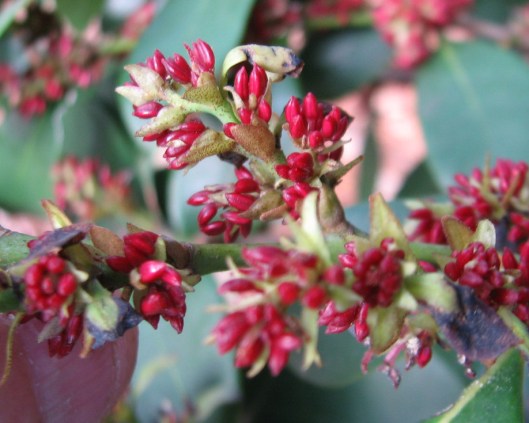








 Genetic characterization. Very little is understood about the genetic diversity in this species. Von Gomez noted that this rare endemic is only known from six locations. They observed the variation in three small populations from two locations. Total variation was low. The smallest pop at Manantlan with only 26 plants revealed the least genetic diversity. Von Gomez suggested focusing on larger populations for in situ conservation work, and creating a plantation from all the populations to capture the maximum amount of available diversity.
Genetic characterization. Very little is understood about the genetic diversity in this species. Von Gomez noted that this rare endemic is only known from six locations. They observed the variation in three small populations from two locations. Total variation was low. The smallest pop at Manantlan with only 26 plants revealed the least genetic diversity. Von Gomez suggested focusing on larger populations for in situ conservation work, and creating a plantation from all the populations to capture the maximum amount of available diversity.



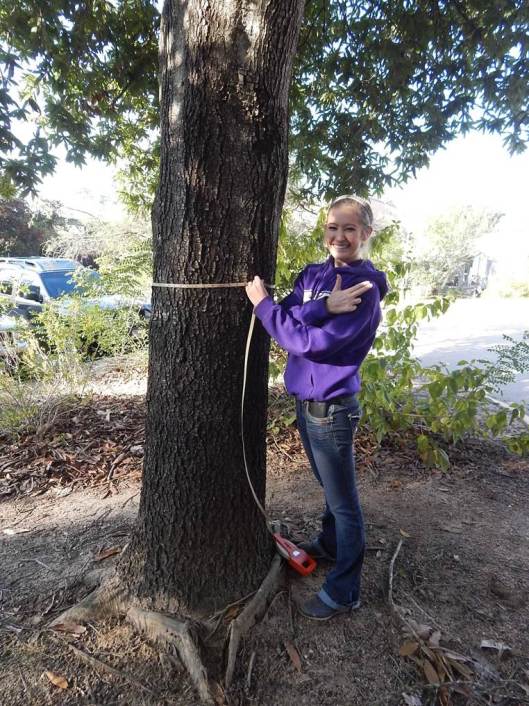


 Once well established, Indian Pink is really a rather reliable returning herbaceous perennial in our area. It grows as a rhizomatous clump between one and two feet high, with about a one to two foot spread. It has supple, sometimes glossy dark green foliage that persists throughout the growing season. From late spring into summer, it bears many upright, tubular, bright crimson flowers with light yellow throats. The plant can be made to rebloom more vigorously if lightly pruned after the first flowering event – blooms on new wood. The five-lobed tips of the flowers open gradually and look like small cream-colored stars perched on red pedestals. In bloom, no plant has greater grace and charm. Under good culture, leaves are robust, clean, and dark green. We need more Indian pink in the shady spots of East Texas landscapes simply because of the charm of genuine native treasure.
Once well established, Indian Pink is really a rather reliable returning herbaceous perennial in our area. It grows as a rhizomatous clump between one and two feet high, with about a one to two foot spread. It has supple, sometimes glossy dark green foliage that persists throughout the growing season. From late spring into summer, it bears many upright, tubular, bright crimson flowers with light yellow throats. The plant can be made to rebloom more vigorously if lightly pruned after the first flowering event – blooms on new wood. The five-lobed tips of the flowers open gradually and look like small cream-colored stars perched on red pedestals. In bloom, no plant has greater grace and charm. Under good culture, leaves are robust, clean, and dark green. We need more Indian pink in the shady spots of East Texas landscapes simply because of the charm of genuine native treasure.